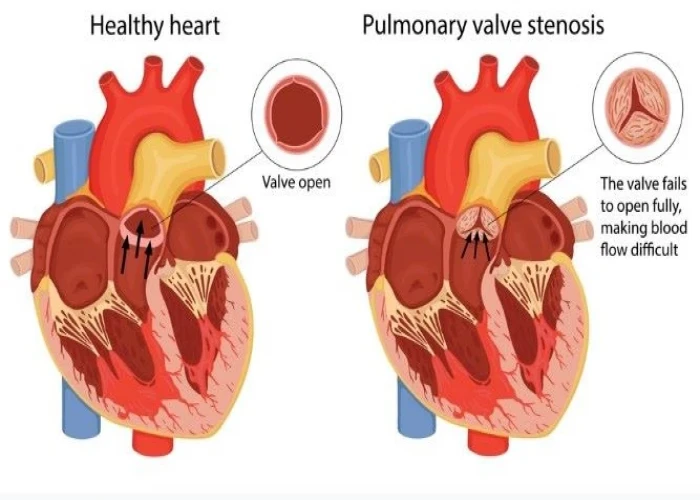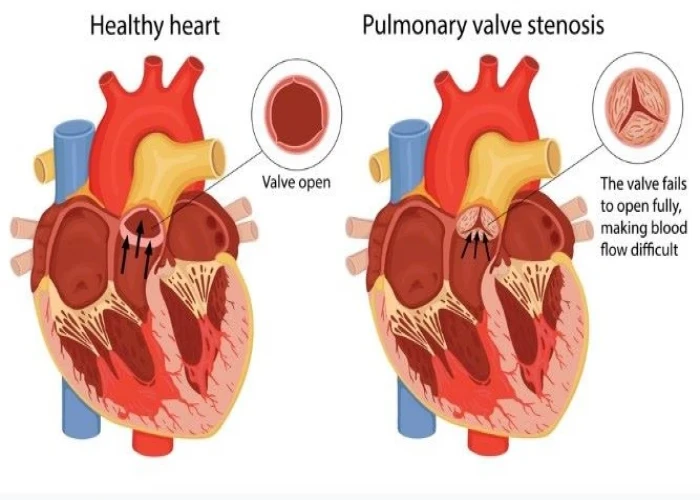 Welcome
Welcome
“May all be happy, may all be healed, may all be at peace and may no one ever suffer."
Pulmonary valve stenosis

Pulmonary valve stenosis is a condition in which the pulmonary valve, which controls blood flow from the right ventricle of the heart to the lungs, becomes narrowed. This narrowing can make it difficult for blood to flow from the heart to the lungs, which can cause a range of symptoms and complications.
Symptoms of pulmonary valve stenosis may include shortness of breath, chest pain, fatigue, fainting or dizziness, and heart palpitations. In some cases, the condition may not cause any noticeable symptoms.
Pulmonary valve stenosis can be caused by a variety of factors, including congenital heart defects, infections, or other underlying medical conditions. In some cases, the cause may be unknown.
Treatment for pulmonary valve stenosis depends on the severity of the condition and the underlying cause. Mild cases may not require any treatment, while more severe cases may require medications to manage symptoms or surgery to repair or replace the valve. Balloon valvuloplasty is a minimally invasive procedure that may be used to treat pulmonary valve stenosis by inserting a catheter with a balloon on the end into the narrowed valve, inflating the balloon to widen the valve opening, and then removing the catheter.
With proper treatment, many people with pulmonary valve stenosis are able to manage their symptoms and lead active, healthy lives. Regular follow-up with a healthcare provider is important to monitor the condition and adjust treatment as needed.
Research Papers
Disease Signs and Symptoms
- Irregular heart sound (heart murmur)
- Fatigue (Tiredness)
- Shortness of breath (dyspnea)
- Chest pain
- Loss of consciousness (fainting)
- A heart murmur an abnormal whooshing sound heard using a stethoscope, caused by turbulent blood flow
Disease Causes
Pulmonary valve stenosis
Pulmonary valve stenosis is most often a congenital heart defect. The exact cause is unclear. The pulmonary valve doesn't develop properly as the baby is growing in the womb.
The pulmonary valve is made of three thin pieces of tissue called flaps (cusps). The cusps open and close with each heartbeat and make sure blood moves in the right direction.
In pulmonary valve stenosis, one or more of the cusps may be stiff or thick, or the cusps may be joined (fused) together. As a result, the valve doesn't open fully. The smaller valve opening makes it harder for blood to flow out of the lower right heart chamber (right ventricle). Pressure increases inside the right ventricle as it tries to push blood through the smaller opening. The increased pressure creates a strain on the heart that eventually causes the right ventricle's muscular wall to thicken.
Disease Prevents
Disease Treatments
If you have mild pulmonary valve stenosis without symptoms, you may only need occasional doctor's checkups.
If you have moderate or severe pulmonary valve stenosis, you may need a heart procedure or heart surgery. The type of procedure or surgery you have depends on your overall health and the appearance of your pulmonary valve.
Heart procedures and surgery used to treat pulmonary valve stenosis include:
- Balloon valvuloplasty. The doctor inserts a flexible tube (catheter) with a balloon on the tip into an artery, usually in the groin. X-rays are used to help guide the catheter to the narrowed valve in the heart. The doctor inflates the balloon, which widens the valve opening, and separates the valve flaps, if needed. The balloon is then deflated. The catheter and balloon are removed.
- Valvuloplasty may improve blood flow through the heart and reduce pulmonary valve stenosis symptoms. However, the valve may narrow again. Some people need valve repair or replacement in the future.
- Pulmonary valve replacement. If balloon valvuloplasty isn't an option, open-heart surgery or a catheter procedure may be done to replace the pulmonary valve. If there are other congenital heart defects, the doctor can often repair those during the same surgery.
- People who have had pulmonary valve replacement need to take antibiotics before certain dental procedures or surgeries to prevent endocarditis.
Disease Diagnoses
Disease Allopathic Generics
Disease Ayurvedic Generics
Disease Homeopathic Generics
Disease yoga
Pulmonary valve stenosis and Learn More about Diseases

Patent ductus arteriosus (PDA)

Bradycardia

Bladder cancer

Ruptured spleen

Jock itch

Back pain

Pyelitis

Inflammatory bowel disease (IBD)
pulmonary valve stenosis, পালমোনারি ভালভ স্টেনোসিস
To be happy, beautiful, healthy, wealthy, hale and long-lived stay with DM3S.
